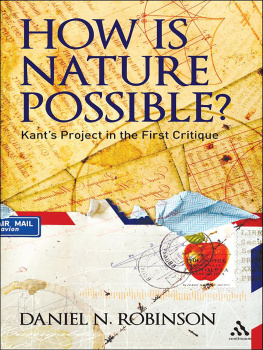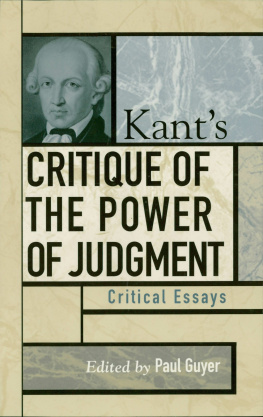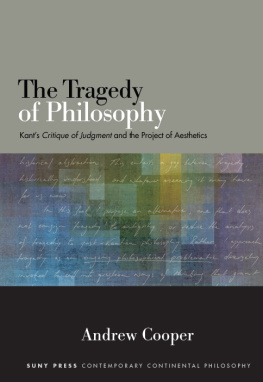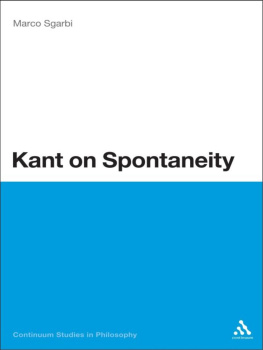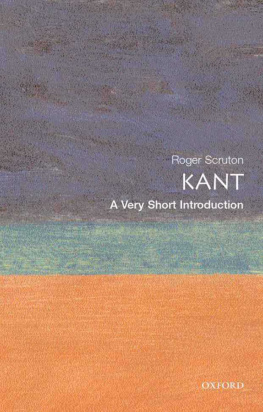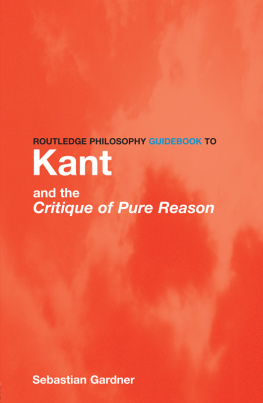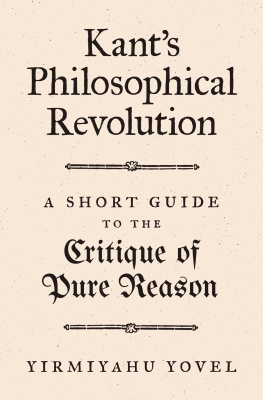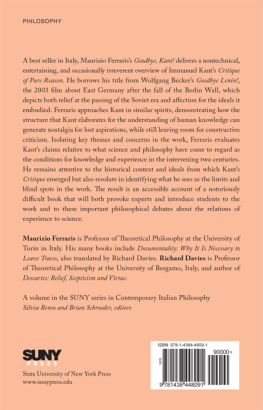HOW IS NATURE POSSIBLE?
HOW IS NATURE POSSIBLE?
KANTS PROJECT IN THE FIRST CRITIQUE
Daniel N. Robinson

Continuum International Publishing Group
The Tower Building, 11 York Road, London SE1 7NX
80 Maiden Lane, New York, NY 10038
www.continuumbooks.com
Daniel N. Robinson 2012
All rights reserved. No part of this publication may be reproduced or transmitted in any form or by any means, electronic or mechanical, including photocopying, recording, or any information storage or retrieval system, without prior permission in writing from the publishers.
The author has asserted his/her right under the Copyright, Designs and Patents Act, 1988, to be identified as Author of this work.
British Library Cataloguing-in-Publication Data
A catalogue record for this book is available from the British Library.
ISBN: 978-1-4411-7801-5
Library of Congress Cataloging-in-Publication Data
Robinson, Daniel N., 1937
How is Nature Possible? : Kants Project in the First Critique / Daniel N.Robinson.
p. cm.
Includes bibliographical references (p. ) and index.
1. Kant, Immanuel, 1724-1804. Kritik der reinen Vernunft. I. Title.
B2779.R55 2011
121-dc23
2011021835
As ever,
For Ciny...
That the human mind will ever give up metaphysical researches is as little to be expected as that we should prefer to give up breathing altogether, to avoid inhaling impure air. There will therefore always be metaphysics in the world; nay, every one, especially every man of reflection, will have it, and for want of a recognized standard, will shape it for himself after his own pattern.
(Immanuel Kant, Prolegomena to Any Future Metaphysics , 367)
PREFACE
In introducing what came to be his influential exposition and assessment of Kants Critique of Pure Reason , Sir Peter Strawson explained his close study of the work as preparation for the Oxford Core Lectures he was to give on the subject. Those of us who have followed him in this difficult assignment are well aware of the demands the Critique imposes and surely share with him what he described as the commingled sense of great insights and great mystification it arouses.
Any treatise that would mystify Sir Peter is one that must put on notice the resources of lesser mortals among whom I readily number myself. Perhaps chiefly for this reason, I have not attempted what Sir Peter then referred to as a unified interpretation for, both before and after the appearance of The Bounds of Sense , there have been many estimable attempts at a unified interpretation. Among the more recent scholars, the names Allison, Ameriks, Beiser, Bennett, Bird, Guyer, and Van Cleve come quickly to mind.
In approaching the work as one who would clarify it for an audience of both generalists and well-prepared students of the text, there are both advantages and liabilities in not being a Kant specialist. The liabilities need little rehearsal. There is no substitute for life-long study if one is to advance original and worthy readings of the works of any major figure in philosophy. Although my interest in Kant covers many years and includes publications on his work, these were not years devoted chiefly to a systematic study of his first Critique. However, in addition to a sharply focused and repeated reading of the text, both in translation and in German, I thought I might bring something else to the undertaking: A long immersion in the history of ideas, some decades of research as an experimental scientist specializing in visual perception, and a quite lengthy engagement with the philosophy of Thomas Reid and those philosophically animated exchanges among Reids and Humes disciples. Such a preparation does not fall into the margins of Kants project but actually moves one closer to its very center. A few words here are in order in relation to Reid, to experimental science and to intellectual history as guides to an through the Critique . Thomas Reids misleadingly dubbed commonsense school takes the settled and evident arrangements within the overall animal economy as proof enough that nature (expressing as he believed the will of a providential Creator) has provided a ready means by which the conundrums and vexations of philosophers are set aside as life is actually lived . One of the keenest and most informed students of science and mathematics, Reid was also confident that any metaphysical theory, doubtful about personal identity and reducing causality to a matter of perceptual coincidences, was simply a philosophical parlor game, but a dangerous one.
As I shall note later in this work, Karl Ameriks finds significant Reidian anticipations in the Critique . There is much more to be said on this subject, particularly in the matter of Reids Geometry of Visibles in relation to non-Euclidean space, but this is the subject for another occasion. I note it here to suggest that an exploration of the works of Humes most formidable contemporary critic in the English-speaking world affords something of a parallel philosophical narrative that augments and clarifies Kants own understanding of and response to Humes challenge. In light of this, it is best to regard that well-rehearsed and dismissive sentence in the Prolegomena where Kant lumps Reid, Beattie, and Oswald as feckless in their attacks on Hume as a bit of academic politics. It should not discourage the sort of comparative analysis suggested here and by Karl Ameriks.
Kants scientific interests and achievements are a matter of record. When he sets out to distinguish between and among the methods proper to science, mathematics, and philosophy he does so with a perspective shaped by actual and disciplined undertakings in each of these areas. It is an acknowledged bias in the following pages to read the Critique as Kants commitment to secure the special domain of the scientifically
knowable against various skeptical challenges. This is not to depreciate the commoner mode of understanding as an additional beneficiary, but to make clear that science itself is constructed out of the same epistemic resources employed by scientists even after their instruments have been put away.
As for intellectual history, it is the vast domain that provided Kant with a veritable specimen chest of failed projects, the often aimless Harumtappen engaged in by those occupying the pantheon of earlier metaphysicians. He is always searching for the birthdate or pedigree or lineage of an argument or theory, even as he proposes alternatives that are universally and necessarily true.
Scholarship, by which I mean disciplined and systematic study, includes science and is inevitably historically and culturally situated. Nonetheless, one measure of originality is the extent to which a given scholar severs the tribal bonds and moves toward something likely to strike others as either idle or trite, when not downright mystifying. Thus, it matters that Kants parents were Pietists. that Halle was at once a treasured but suffocatingly orthodox setting, that the partisans of Leibniz and of Newton were at war on more than one front, and that entire domains of scholarly inquiry could be supported or suspended by a stroke of the Prussian royal pen. Of course, it all matters, but there must be selection, filtering, distillation, rules of indifference. Much was made of and made with the pages of the Critique . Kant would not have approved of all of it and went so far as to correct many attempts that surfaced in his own time. What I hope to present here is what I take to be Kants own purposes and how he set about to realize them. In various places in the following pages it is instructive to present serious criticisms of ideas and arguments on which the overall project of the
Next page
